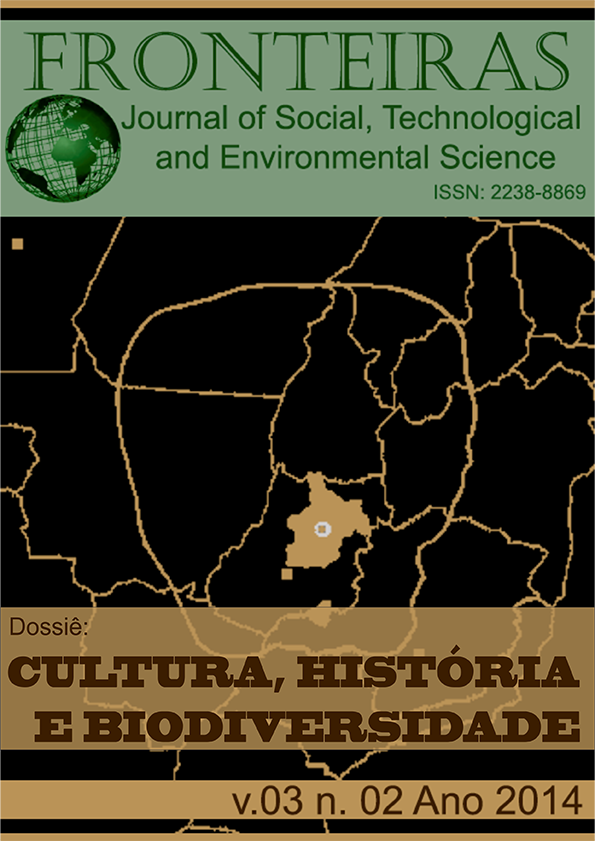Endemic Birds of the Cerrado Region in Goiás State, Brazil
DOI:
https://doi.org/10.21664/2238-8869.2014v3i2.p45-54Abstract
Endemic species have been recognized in conservation strategy issues, and mainly considering that many of the endemic bird species of Cerrado biome are also endangered. This study examined the occurrence of endemic bird species of the Cerrado in Goiás State, discussing the role of the State in preserving of its avifauna. The State is fully inserted into this biome, and considered highly important for the conservation of regional biodiversity. Its high richness of bird species, as well as the high representation of endemic and threatened species takes place at the center of strategies for the conservation of the avifauna of Cerrado. Its main Protected Areas, Emas and Chapada dos Veadeiros National Parks, proved extremely relevant in representing the richness of the biome, as well as the endemic and endangered species, and are a central component of wildlife conservation in the Cerrado. Moreover, primary focus should be given to the endemism centers in the Paranã and Araguaia River Valleys to ensure the conservation of endemic bird species of restricted distribution in the State.
Keywords: Endangered Species; Conservation; Protected Areas
References
Bibby C 1994. Recent past and future extinction in birds. Phil. Trans. Roy. Soc. Lond. B344 (1307): 35–40.
BirdLife International. Species factsheet: Conothraupis mesoleuca. 2014a [citado 20 out. 2014]. Disponível em: http://www.birdlife.org.
BirdLife International. Species factsheet: Celeus obrieni. . 2014b [citado 20 out. 2014]. Disponível em: http://www.birdlife.org.
Braz VS 2008. Ecologia e conservação das aves campestres do bioma Cerrado. Tese de Doutorado. Universidade de Brasília.
Braz VS, França FGR 2008. Aves da Chapada dos Veadeiros. Fotos: Edson Endrigo. Aves & Fotos Editora. São Paulo.
Cavalcanti RB 1999. Bird species richness and conservation in the cerrado region of central Brazil. Studies in Avian Biology 19: 244-249.
del Hoyo J, Elliott A, Christie DA (eds.) 2004. Handbook of the birds of the world. Vol. 9. Cotingas to pipits and wagtails. Barcelona: Lynx Edicions.
Dornas T, Valle NC, Hidasi J 2009. Celeus obrieni: Dois novos registros históricos para o estado de Goiás. Atual Ornitol 147 (2009): 18-19.
Ferreira AA, Bastos RP, Ferreira ME 2008. Estado-da-arte sobre a biodiversidade de vertebrados em Goiás.. In: Ferreira, L.G. (Org.). A encruzilhada socioambiental – biodiversidade, economia e sustentabilidade no cerrado. Goiânia, Editora UFG.
Hass A 2004. Plano de Manejo do Parque Nacional das Emas, Goiás. Relatório do grupo temático AVES. IBAMA.
Hass A 2008 a. Columbina cyanopis (Pelzeln, 1870). In: Machado ABM, Drummond GM.; Paglia AP (eds). Livro Vermelho da Fauna Brasileira Ameaçada de Extinção. Volume II. Brasília, DF: Ministério do Meio Ambiente, 453-455 pp.
Hass A 2008b. Eleothreptus candicans (Pelzeln, 1867 In: Machado ABM, Drummond GM.; Paglia AP (eds). Livro Vermelho da Fauna Brasileira Ameaçada de Extinção. Volume II. Brasília, DF: Ministério do Meio Ambiente, 488-489 pp.
Hidasi J 2007. Aves de Goiás. Goiânia: Editora da UCG.
Hidasi J, Mendonça LG, Blamires D 2008. Primeiro registro documentado de Celeus obrieni (Picidae) para o Estado de Goiás, Brasil. Rev. Bras. Orn. 16: 373–375.
IUCN. The IUCN Red List of Threatened Species. Version 2014.2. . 2014 [citado 20 out. 2014]. Disponível em: http://www.iucnredlist.org.
Lobo F, Guimarães LF 2009. Vegetação remanescente nas áreas prioritárias para conservação da biodiversidade em Goiás: padrões de distribuição e características. Boletim Goiano de Geografia, 28(2), 89-102.
Machado ABM, Drummond GM, Paglia, AP 2008. Livro vermelho da fauna brasileira ameaçada de extinção. Ministério do Meio Ambiente-MMA.
Marini MA, Garcia FI. 2005. Conservação de aves no Brasil. Megadiversidade 1:95-102.
MMA (Ministério do Meio Ambiente). Instrução Normativa MMA de 27 de maio de 2003. 2003 [citado 20 out. 2014]. Disponível em: http://www.mma.gov.br.
Myers N 1988. Threatened biotas: “Hot spots” in tropical forests. The Evironmentalist 8: 1–20
Myers N 1990. The biodiversity challenge: Expanded hotspots analysis. The Environmentalist 10: 243–256
Myers N, Mittermeier RA, Mittermeier CG, da Fonseca GAB, Kent J. 2000. Biodiversity hotspots for conservation priorities. Nature 403: 853–858.
Olmos F 2008. Cercomacra ferdinandi. In: Machado ABM, Drummond GM.; Paglia AP (eds). Livro Vermelho da Fauna Brasileira Ameaçada de Extinção. Volume II. Brasília, DF: Ministério do Meio Ambiente, 597-598 pp.
Pinheiro RT, Dornas T, Leite GA, Crozariol MA, Marcelino DG and Corrêa AG 2012. Novos registros do pica-pau-do-parnaíba Celeus obrieni e status conservação no estado de Goiás, Brasil. Rev Bras Ornitol 20: 59-64.
Sano EE, Dambrós L.A., Oliveira, G.C.; Brites, R.S 2008. Padrões de cobertura de solos do Estado de Goiás. In: Ferreira, L.G. (org.). In: Ferreira, L.G. (Org.). A encruzilhada socioambien¬tal – biodiversidade, economia e sustentabilidade no cerrado. Goiânia, Editora UFG, 91-106 pp.
SEMARH. 2014 [citado 20 out. 2014]. Disponível em: http://www.semarh.goias.gov.br/.
Sick H. 1985. Ornitologia brasileira: uma introdução. Editora da Universidade de Brasília, Brasília.
Silva JMC 1995. Birds of the Cerrado region, South America. Steenstrupia 21: 69-92.
Silva JMC, Bates JM 2002. Biogeographic patterns and conservation in the South American Cerrado: a tropical savanna hotspot. BioScience 52: 225-233.
Silveira LF 2008a. Penelope ochrogaster Pelzeln, 1870 . In: Machado ABM, Drummond GM.; Paglia AP (eds). Livro Vermelho da Fauna Brasileira Ameaçada de Extinção. Volume II. Brasília, DF: Ministério do Meio Ambiente, 435-436 pp.
Silveira LF 2008b. Synallaxis simoni Hellmayr, 1907. In Machado ABM, Drummond GM.; Paglia AP (eds). Livro Vermelho da Fauna Brasileira Ameaçada de Extinção. Volume II. Brasília, DF: Ministério do Meio Ambiente, 581-582 pp.
Published
How to Cite
Issue
Section
License
This journal offers immediate free access to its content, following the principle that providing free scientific knowledge to the public, we provides greater global democratization of knowledge.
As of the publication in the journal the authors have copyright and publication rights of their articles without restrictions.
The Revista Fronteiras: Journal of Social, Technological and Environmental Science follows the legal precepts of the Creative Commons - Attribution-NonCommercial-ShareAlike 4.0 International. 


